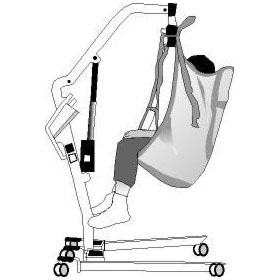
ALS Ice Bucket Challenge Progress


Caregiving for someone with ALS is an act of love, and sometimes an act of muscle. That’s where a “patient lift”─ of which there are many types ─ may be a life and back-saving device. Lifts can be brought into the home when limited mobility is one of the issues our loved ones face and, by association, caregivers too.
Sometimes called “lifters,” the devices are often designed based on the science of “hydraulic” engineering, not unlike hospital beds with their effective mix of motion and mechanics to assist in enabling repositioning and therefore more comfort. In the case of lifts specifically, they can allow for safer moves across a room for people with ALS who may lack muscle strength or are unable to stand without help.
Lifters can be referred to by several different names, including a hydraulic, a sit-to-stand, a sling, or by the brand names, “Hoyer Lift,” “Lexa,” “Prism,” and many others. The sling label comes from the material used to safely cradle people as they are transferred between a chair and bed, bed and sofa, or wheelchair and commode. According to Dr. Charlotte Chatto, PT, Ph.D., an assistant professor and a physical therapist at an ALS Association Certified Treatment Center of Excellence in Georgia, another important practical consideration is whether or not to leave the Hoyer Lift sling under the person once he or she has been transferred. “It is generally recommended that you remove the sling for comfort and protection of the skin,” Dr. Chatto explains, particularly because a person living with ALS has limitations when it comes to shifting positions to relieve pressure or irritation. “The sling should definitely be removed before prolonged periods of sitting or lying down,” she said, adding that a general rule of thumb is to communicate with each other and always to give “…careful consideration of the sling placement to maximize skin protection and patient comfort.”
Still, not all lifts use a sling. Other designs rely on belts and straps in conjunction with vests to secure movement from Point A to Point B. Because people come in different shapes and sizes, so do lifts, with different models designed to accommodate physical diversity.
The correct fit in terms of weight in pounds is important, both for the person with ALS and caregiver safety. Similarly, proper positioning of individuals in a lift is key to avoid back injury for the caregiver. When it comes to lifters, applying the adage, “The shortest distance between two points is a straight line,” is applicable. In other words, as much as possible, narrow the direct space between a person’s chair and their bed, for example, limiting the distance the lift has to travel or rotate, making injury to the individual and caregiver much less likely. Following the 10 Golden Rules During a Transfer offers valuable guidance.
 More than Meets the Eye
More than Meets the EyeThe choices as they pertain to lifters don’t end there. Some are manually operated, some electric, and others, battery-powered. They also include floor-based models and overhead units that can be a ceiling or track-mount. Lifts can be rented or bought outright. Cost, of course, varies too, as does insurance coverage.
Given the array of options and safety precautions urged by professionals in general, it’s important to do homework, consulting with your physician or medical professional before writing a check to cover the fee. YouTube gives ready access to demonstrations, caregiver training videos, informational how-to’s, lift-and-transfer techniques, and much more from a range of manufacturers. ”How-Tos” for Hoyer Lifts are also available but should serve as a complement only to professional assistance in learning the correct and safe use of a lift. You can also learn more about mobile floor lifts and overhead units from online sources such as the Lift Doctor, who has a range of advice to offer on everything from ergonomics to injury prevention. While the range of tutorials and demonstrations offers a great way to get oriented to lifts, the best approach is to consult with a medical professional for direction and guidance in safety procedures and the specifics of how to properly use them.